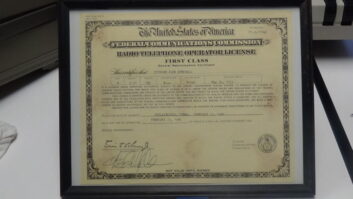The 5 kHz Bandwidth Reduction Trashes a Struggling Service – and Listeners Do Notice
While I understand the premise of the decision to reduce AM bandwidth to 5 kHz – and all too well – I still have a problem with the mathematics and psychology of it all.
I’ve been in this business for over 20 years and engineered for a good many years of that. Never since the discussion of NRSC have I seen such venom spat by the different factions on the subject of bandwidth restriction.
First off, what happened to the expanded AM band? There was a theory kicked around that the AM broadcast band could be “thinned” out to reduce congestion. That never really materialized; the radios are readily available to the listener, but hardly anything is there to listen to.
Second, when I was taught AM transmission theory at Valparaiso Technical Institute in Valparaiso, Ind., I learned that the modulation bandwidth was 10 kHz above and below the carrier frequency, with a 10 kHz protection on either side. That makes a station’s occupation at one spot on the dial 40 kHz wide!
Now, I don’t know who put wax in the ears of the proponents of 5 kHz bandwidth, and who talked them into the idea that the listener won’t notice a difference; but I do notice a huge difference in the freshness of the highs on my AM stations when the highs are severely rolled back.
Does this mean we scrap NRSC, which complicated sideband splatter and harmonic problems and never should have been implemented?
Too much ‘woof’
Ask me, and I would say roll back AM audio to flat EQ and 10 kHz bandwidth again, spread the stations out as originally intended and make receivers good enough to give appreciable audio quality. The problem would be solved for analog AM radio.
But I would also have to agree that it’s time to move on, technologically speaking. I just think that it should be done like TV: Move AM service to a new piece of spectrum for digital, and quietly legislate the forcible removal of analog service from the existing AM band or give it up to something else.
But please don’t trash a service that’s already suffering at the hands of cheap radios with bad circuits. I definitely don’t want to be listening to AM audio that sounds like mud and makes the speakers in my car rattle because of too much “woof.”
Besides, if listeners don’t notice the audio quality at 5 kHz, why do they notice the difference in FM audio? Why do they notice that CDs sound better than FM? Could it be that high frequencies in the audio create interference patterns in the lower frequencies, making the audio more “hi-fi”?
I think Doctor Bose would at least agree that even frequencies we can’t hear have an impact on those we do. Why else build microphones that have supersonic capture ability? Why do we have digital recording with super-high sampling rates? Because highs in the audio do matter. I need highs in my AM audio to understand what’s being played by the station in order to overcome the road noise of my car. If it’s too muddy, it sounds like the road noise.
By the way, if you want to reduce sideband interference, why not go Single Sideband? The receivers can be easily modified with a beat oscillator adapted from the heterodyne circuit – a piece of cake for most transistor and IC-based radios today. But I digress in sarcasm here.
Full-throated AM
Not every market is beset with sideband interference issues. In fact, I would venture a good guess that those stations are in the minority, although it doesn’t seem like it to the big-city guys who seem to set policy for the rest of us out here because they’re the ones having problems because of too many licensees in a given market.
Based upon the logic of several proponents I’ve heard, maybe those stations experiencing the interference should roll back their highs. But most of the rural stations, especially Class As, are still doing fine with NRSC at 10 kHz (upper and lower sidebands). And our listeners do notice. I’ve heard it straight from their mouths.
I am proud of a full-throated sound of my AM stations and intend to keep it that way as long as possible. And if technology supplants analog service, I welcome the day. But until everybody can make up their cotton-picking mind how it’s going to be done, please don’t trash a service that’s already struggling with its identity.
I know some of you out there don’t see it this way, and that’s the wonderful thing about America and Radio World’s Reader’s Forum; at least we can agree to disagree. But I, at least, have a legacy of old engineering practices dating back for more than 80 years to help me decide what’s the right thing. And 5 kHz audio equates to going back to the days when we used carbon microphones and mechanical oscillators.
At least the audio will truly sound “retro.”










